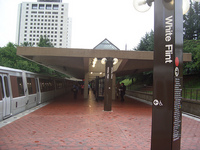For Montgomery’s future, look to Arlington
Montgomery County Councilmember Roger Berliner (D-District 1) has proposed adding an additional Metro station near the existing White Flint station. Mr. Berliner proposed the station to enhance the pedestrian-oriented infrastructure for the upcoming suburban-to-urban retrofits in the new White Flint Sector Plan and to address the expected traffic from BRAC. He noted that a new station would cost much less than all the road widening SHA plans around the National Naval Medical Center.
“To the extent to which we have an existing infrastructure that we could advance that would be of the highest quality, I think that’s worth a good look,” Berliner told the Gazette. The amount of land that is within walking distance of transit almost doubles when two stations are within walking distance of each other compared to when they are farther apart. In the specific case of the White Flint Sector Plan, that would double the amount of residents and amenities that the infrastructure could support.
While it would be wonderful to establish a corridor similar to Rosslyn-Ballston, this proposal also represents a shift in thinking about how to plan for BRAC. While hosting the National Institutes of Health and the Navy Medical Center create planning challenges for the county, they also provide large numbers of jobs. More new residents will move to to Montgomery County as those facilities grow. In previous decades, planners would widen the existing roads, build more roads at the rural fringes of the county, then approve more subdivisions. More undeveloped land gets paid over, more impermeable surfaces are created, more animals lose their habitat, and our nation spends even more money on gasoline.
Berliner’s vision represents a break from previous decades. Rather than building more roads, a Metro station would support more housing within walking distance of a Metro station just a few stops from Medical Center. While more tax-paying residents help the County financially, the vision also helps the environment by avoiding paving over acres of undeveloped land. It also won’t require the new residents to spend income purchasing, maintaining, and fueling up personal automobiles.
Montgomery County facing similar challenges to those Arlington County faced forty years ago. Arlington fought so hard to use the Orange Line as a planning tool because it was running out of undeveloped land within its borders. If an urbanized jurisdiction can’t grow, it can’t expand its tax base. If it can’t expand its tax base, it faces insolvency in the long term. Since Arlington County couldn’t grow out anymore, it had to grow up in selected places.
Currently, over 30% of the county’s tax base comes from the Rosslyn-Ballston Corridor, 8% of the county’s land area. Montgomery is much larger, which delayed this process by decades, but it’s now approaching on the horizon. Tysons, too, is hitting a wall in how much economic activity it can support, which is why Fairfax leaders are so eager to build the Silver Line.
Not only would Councilmember Berliner’s vision provide conditions for a more environmentally sustainable living arrangement for thousands of future Montgomery County residents, it will improve the county’s fiscal situation in the short term. By establishing a corridor and planting the seeds for achieving an economically self-sustaining critical mass in a new human-scale walkable urban place, it will also create another place for the county to focus its long-term growth. By having environmentally and economically sustainable long-term growth, the county will be fiscally solvent in the long-term.
In other words, Berliner’s vision is just plain Smart.

